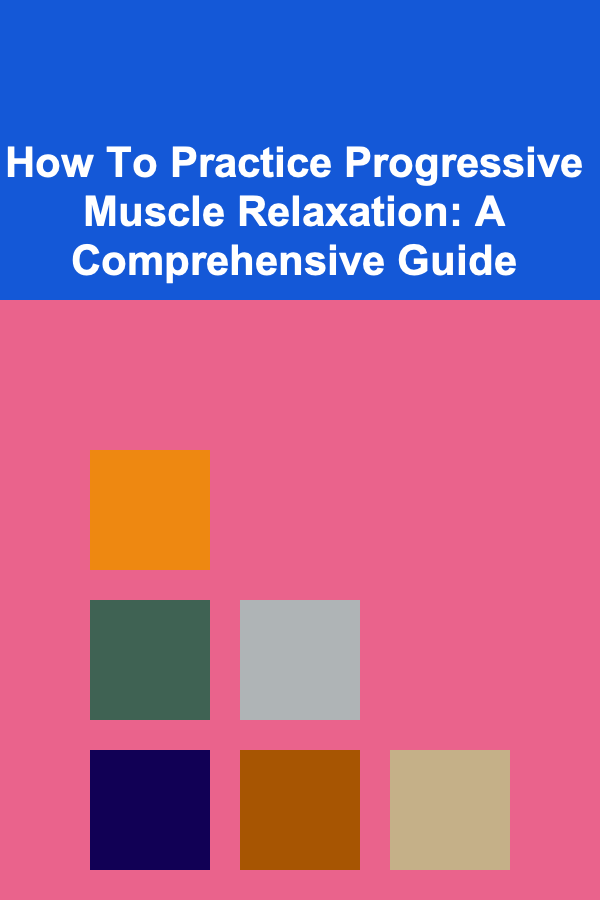
How To Practice Progressive Muscle Relaxation: A Comprehensive Guide
ebook include PDF & Audio bundle (Micro Guide)
$12.99$6.99
Limited Time Offer! Order within the next:

Introduction to Progressive Muscle Relaxation (PMR)
In today's fast-paced world, stress and anxiety have become increasingly prevalent. These conditions can manifest in various physical and mental symptoms, impacting our overall well-being. While there are numerous approaches to managing stress, Progressive Muscle Relaxation (PMR) stands out as a simple yet highly effective technique. PMR involves systematically tensing and releasing different muscle groups in the body, allowing individuals to become more aware of the physical sensations of tension and relaxation. This heightened awareness enables them to consciously reduce muscle tension and promote a state of deep relaxation.
Developed in the 1920s by American physician Edmund Jacobson, PMR is based on the principle that mental anxiety can lead to muscle tension and vice versa. By consciously relaxing the muscles, the mind can also be calmed, breaking the cycle of stress and tension. Over the years, PMR has been extensively researched and proven to be beneficial for a wide range of conditions, including anxiety disorders, insomnia, chronic pain, hypertension, and even side effects of cancer treatment.
This guide provides a comprehensive overview of PMR, covering its benefits, how to practice it effectively, and tips for incorporating it into your daily life. Whether you're new to relaxation techniques or looking to enhance your existing stress management strategies, this resource will equip you with the knowledge and tools to harness the power of PMR.
Benefits of Progressive Muscle Relaxation
The benefits of PMR extend far beyond simply feeling relaxed. Regular practice can lead to significant improvements in both physical and mental health. Here are some of the key advantages:
- Reduced Anxiety and Stress: PMR is a powerful tool for managing anxiety and stress. By consciously relaxing the muscles, it can interrupt the physiological responses associated with anxiety, such as increased heart rate, rapid breathing, and muscle tension.
- Improved Sleep Quality: Muscle tension can contribute to sleep disturbances. PMR can help relax the body and mind, making it easier to fall asleep and stay asleep. It's often used as a complementary therapy for insomnia.
- Pain Management: PMR can be an effective strategy for managing chronic pain conditions such as fibromyalgia, tension headaches, and back pain. By reducing muscle tension and promoting relaxation, it can help alleviate pain and improve overall comfort.
- Lower Blood Pressure: Studies have shown that regular PMR practice can help lower blood pressure in individuals with hypertension. This is likely due to the relaxation response, which counteracts the effects of stress hormones on the cardiovascular system.
- Enhanced Mood and Emotional Regulation: PMR can have a positive impact on mood and emotional regulation. By promoting relaxation and reducing stress, it can help alleviate symptoms of depression and improve overall emotional well-being.
- Increased Self-Awareness: PMR encourages individuals to pay attention to the sensations in their body, fostering a greater awareness of the relationship between physical tension and emotional states. This heightened self-awareness can be valuable for identifying and managing stress triggers.
- Improved Coping Skills: PMR can be used as a coping mechanism in stressful situations. By practicing regularly, individuals can learn to quickly induce relaxation and manage anxiety symptoms when they arise.
- Reduced Muscle Tension: Of course, one of the most direct benefits is the reduction of muscle tension itself. This can alleviate aches, pains, and stiffness associated with chronic tension.
Preparing for PMR
Before you begin practicing PMR, it's important to create a conducive environment and prepare yourself mentally and physically. Here's a step-by-step guide to getting ready:
- Choose a Quiet and Comfortable Environment: Find a place where you can lie down or sit comfortably without being disturbed. Minimize distractions such as noise, bright lights, and interruptions. A quiet room with soft lighting is ideal.
- Wear Loose and Comfortable Clothing: Tight clothing can restrict movement and hinder relaxation. Opt for loose-fitting clothes that allow you to move freely.
- Remove Distractions: Turn off your phone, computer, and any other electronic devices that might interrupt your practice. Let your family or housemates know that you need some uninterrupted time.
- Find a Comfortable Position: You can practice PMR either lying down or sitting in a comfortable chair. If lying down, use a pillow to support your head and neck. If sitting, ensure your back is supported and your feet are flat on the floor.
- Take a Few Deep Breaths: Before you begin tensing and releasing your muscles, take a few slow, deep breaths. This will help you relax and center yourself. Inhale deeply through your nose, filling your lungs completely, and exhale slowly through your mouth. Focus on the sensation of your breath moving in and out of your body.
- Mental Preparation: Take a moment to mentally prepare yourself for the practice. Let go of any thoughts or worries that are occupying your mind. Focus on the present moment and the task at hand: relaxing your muscles and calming your mind.
- Optional: Use Guided Meditations or Recordings: Many guided PMR recordings are available online or through apps. These can be helpful for beginners as they provide step-by-step instructions and can make the process easier to follow. If you choose to use a recording, make sure it's one you find calming and soothing.
Step-by-Step Guide to Practicing PMR
The core of PMR involves systematically tensing and releasing different muscle groups. Follow these steps to guide you through the process. Remember to breathe deeply and pay attention to the sensations in your body.
- Hands:
- Tense: Make a tight fist with both hands, squeezing as hard as you can. Notice the tension in your hands, forearms, and wrists. Hold for 5-10 seconds.
- Release: Slowly release the tension, letting your fingers unfold and your hands relax completely. Pay attention to the feeling of relaxation as the tension dissipates. Hold for 15-30 seconds.
- Arms (Biceps):
- Tense: Bend your elbows and tense your biceps, making a strong muscle. Feel the tension in your upper arms. Hold for 5-10 seconds.
- Release: Slowly release the tension, letting your arms relax completely. Notice the difference between the tense and relaxed state. Hold for 15-30 seconds.
- Arms (Triceps):
- Tense: Extend your arms straight out in front of you and tense your triceps, as if you were pushing against something. Feel the tension in the back of your upper arms. Hold for 5-10 seconds.
- Release: Slowly release the tension, letting your arms relax completely. Hold for 15-30 seconds.
- Forehead:
- Tense: Raise your eyebrows as high as you can, creating wrinkles on your forehead. Feel the tension in your forehead and scalp. Hold for 5-10 seconds.
- Release: Slowly release the tension, letting your forehead smooth out. Hold for 15-30 seconds.
- Eyes and Nose:
- Tense: Close your eyes tightly and wrinkle your nose. Feel the tension around your eyes and nose. Hold for 5-10 seconds.
- Release: Slowly release the tension, letting your face relax completely. Hold for 15-30 seconds.
- Jaw:
- Tense: Clench your teeth tightly, and feel the tension in your jaw muscles. Be careful not to over-tense. Hold for 5-10 seconds.
- Release: Slowly release the tension, letting your jaw relax and your mouth slightly open. Hold for 15-30 seconds.
- Neck:
- Tense: Gently press your head back against the surface you are lying or sitting on, tensing the muscles in the back of your neck. Hold for 5-10 seconds.
- Release: Slowly release the tension, letting your neck relax completely. Hold for 15-30 seconds.
- Tense (Alternative): Gently bring your chin towards your chest, tensing the muscles in the front of your neck. Hold for 5-10 seconds.
- Release: Slowly release the tension, letting your neck relax completely. Hold for 15-30 seconds.
- Shoulders:
- Tense: Shrug your shoulders up towards your ears, tensing the muscles in your shoulders and upper back. Hold for 5-10 seconds.
- Release: Slowly release the tension, letting your shoulders drop down. Hold for 15-30 seconds.
- Chest:
- Tense: Take a deep breath and hold it, tensing the muscles in your chest. Hold for 5-10 seconds.
- Release: Slowly release your breath and let your chest relax completely. Hold for 15-30 seconds.
- Stomach:
- Tense: Tighten your stomach muscles as if you were preparing to be punched in the stomach. Hold for 5-10 seconds.
- Release: Slowly release the tension, letting your stomach relax completely. Hold for 15-30 seconds.
- Buttocks:
- Tense: Squeeze your buttock muscles together tightly. Hold for 5-10 seconds.
- Release: Slowly release the tension, letting your buttocks relax completely. Hold for 15-30 seconds.
- Thighs:
- Tense: Tense your thigh muscles as if you were trying to lift your legs off the ground. Hold for 5-10 seconds.
- Release: Slowly release the tension, letting your thighs relax completely. Hold for 15-30 seconds.
- Calves:
- Tense: Point your toes downwards, tensing the muscles in your calves. Hold for 5-10 seconds.
- Release: Slowly release the tension, letting your calves relax completely. Hold for 15-30 seconds.
- Feet:
- Tense: Curl your toes under, tensing the muscles in your feet. Hold for 5-10 seconds.
- Release: Slowly release the tension, letting your feet relax completely. Hold for 15-30 seconds.
After completing all the muscle groups, take a few minutes to lie still and enjoy the feeling of deep relaxation. Focus on your breath and allow your mind to drift. You may feel a sense of calmness and peace.
Tips for Effective PMR Practice
To maximize the benefits of PMR, consider these tips:
- Consistency is Key: Practice PMR regularly, ideally once or twice a day. Even 10-15 minutes of daily practice can make a significant difference in your stress levels.
- Don't Overdo It: When tensing your muscles, avoid straining yourself. The goal is to create a noticeable tension, but not to cause pain or discomfort. If you have any injuries or medical conditions, consult with your doctor before starting PMR.
- Focus on the Sensations: Pay close attention to the sensations in your body as you tense and release each muscle group. Notice the difference between tension and relaxation. This heightened awareness will help you identify and manage muscle tension more effectively.
- Adjust the Duration: The recommended duration for tensing (5-10 seconds) and releasing (15-30 seconds) is a guideline. Feel free to adjust these timings based on your individual needs and preferences. Some people may find that they need more time to release the tension, while others may prefer shorter intervals.
- Be Patient: It takes time and practice to become proficient in PMR. Don't get discouraged if you don't feel completely relaxed during your first few sessions. With continued practice, you will become more skilled at identifying and releasing muscle tension.
- Adapt the Routine: You can adapt the PMR routine to fit your specific needs and preferences. For example, if you have a particular area of your body that tends to hold tension (e.g., neck and shoulders), you can spend more time focusing on those muscle groups.
- Combine with Other Relaxation Techniques: PMR can be effectively combined with other relaxation techniques, such as deep breathing exercises, meditation, and visualization. Experiment with different combinations to find what works best for you.
- Practice Mindful Awareness: Throughout the process, be mindful of your thoughts and feelings. If your mind wanders, gently redirect your attention back to your body and your breath.
- Consider a Professional: If you are struggling to practice PMR on your own, consider seeking guidance from a qualified healthcare professional, such as a therapist or counselor. They can provide personalized instructions and support to help you get the most out of the technique.
Troubleshooting Common Challenges
While PMR is generally a safe and effective technique, some individuals may encounter challenges when practicing it. Here are some common issues and how to address them:
- Difficulty Tensing Muscles: Some people may find it difficult to consciously tense certain muscle groups. If this is the case, try focusing on the movement that the muscle is responsible for. For example, if you're having trouble tensing your biceps, try imagining yourself lifting a heavy weight.
- Muscle Cramps: If you experience muscle cramps during PMR, stop the exercise immediately and gently stretch the affected muscle. Avoid tensing the muscle again until it has fully recovered. Make sure you are hydrated, as dehydration can contribute to muscle cramps.
- Feeling Anxious or Agitated: While PMR is intended to promote relaxation, some individuals may initially feel anxious or agitated. This is often due to heightened awareness of physical sensations. If this happens, try reducing the intensity of the muscle tension and focusing on your breath. You can also try practicing PMR for shorter periods of time.
- Falling Asleep: If you tend to fall asleep during PMR, try practicing it in a sitting position or at a time of day when you are more alert. You can also try using a slightly brighter light or playing some soft music in the background.
- Mind Wandering: It's normal for your mind to wander during PMR. When this happens, gently redirect your attention back to your body and your breath. Don't judge yourself for having wandering thoughts; simply acknowledge them and let them go.
- Lack of Time: Many people find it difficult to incorporate PMR into their busy schedules. However, even a few minutes of practice can be beneficial. Try breaking the routine into smaller segments that you can do throughout the day. For example, you can practice a few muscle groups during your lunch break or before going to bed.
Adapting PMR for Different Situations
The beauty of PMR lies in its adaptability. While a full PMR session is ideal, you can modify the technique to suit different situations and time constraints. Here are some examples:
- Mini-PMR: When you only have a few minutes, focus on the muscle groups that tend to hold the most tension, such as your neck, shoulders, and jaw.
- Chair-Based PMR: If you can't lie down, you can practice PMR while sitting in a chair. Focus on tensing and releasing the muscles in your upper body, such as your hands, arms, shoulders, and face.
- PMR in Public: While it's not practical to do a full PMR session in public, you can use subtle muscle relaxation techniques to manage stress and anxiety. For example, you can gently release tension in your jaw or shoulders without anyone noticing.
- PMR Before Sleep: Practicing PMR before going to bed can help you relax and fall asleep more easily. Focus on tensing and releasing the muscles in your body in a slow and deliberate manner.
- PMR During Stressful Situations: If you find yourself in a stressful situation, take a few deep breaths and focus on releasing tension in your muscles. You can also try practicing a mini-PMR session to quickly calm your mind and body.
Integrating PMR into Your Lifestyle
PMR is most effective when it's integrated into your daily lifestyle as a regular practice. Here are some tips for making it a sustainable habit:
- Schedule Time for PMR: Treat PMR like any other important appointment and schedule time for it in your calendar. Consistency is key to reaping the benefits of the technique.
- Create a Routine: Establish a consistent routine for practicing PMR. For example, you might practice it every morning after waking up or every evening before going to bed.
- Find a Buddy: Partner with a friend or family member who is also interested in learning PMR. You can support each other and keep each other accountable.
- Use Technology: Utilize apps and online resources to guide you through PMR sessions. Many apps offer guided meditations and customizable routines.
- Reward Yourself: Reward yourself for sticking to your PMR routine. This will help you stay motivated and make the practice more enjoyable.
- Be Flexible: Life happens, and you may not always be able to stick to your PMR schedule. Don't beat yourself up if you miss a session. Simply get back on track as soon as possible.
Scientific Evidence and Research on PMR
PMR is not just a feel-good technique; it's backed by a substantial body of scientific evidence. Research has consistently demonstrated its effectiveness in managing various conditions and improving overall well-being. Here are some key findings:
- Anxiety Disorders: Numerous studies have shown that PMR can significantly reduce anxiety symptoms in individuals with generalized anxiety disorder, social anxiety disorder, and panic disorder.
- Insomnia: Research has indicated that PMR can improve sleep quality in individuals with insomnia. It can help reduce sleep latency (the time it takes to fall asleep), increase sleep duration, and improve sleep efficiency.
- Chronic Pain: Studies have found that PMR can be an effective strategy for managing chronic pain conditions such as fibromyalgia, tension headaches, and back pain. It can help reduce pain intensity, improve physical function, and enhance quality of life.
- Hypertension: Research has shown that regular PMR practice can help lower blood pressure in individuals with hypertension. This effect is likely due to the relaxation response, which counteracts the effects of stress hormones on the cardiovascular system.
- Cancer-Related Symptoms: PMR has been found to be helpful in managing some of the side effects of cancer treatment, such as fatigue, nausea, and pain.
- Post-Traumatic Stress Disorder (PTSD): While more research is needed, some studies suggest that PMR may be beneficial for individuals with PTSD by helping them manage anxiety and improve emotional regulation.
The research on PMR continues to evolve, with ongoing studies exploring its potential benefits for a wider range of conditions. The consistent findings from these studies provide strong support for the effectiveness of PMR as a valuable tool for stress management and overall well-being.
Conclusion
Progressive Muscle Relaxation is a powerful and versatile technique for managing stress, anxiety, and a variety of other conditions. By systematically tensing and releasing different muscle groups, you can become more aware of the physical sensations of tension and relaxation, allowing you to consciously reduce muscle tension and promote a state of deep relaxation. With regular practice, PMR can lead to significant improvements in both your physical and mental health.
This guide has provided a comprehensive overview of PMR, covering its benefits, how to practice it effectively, tips for incorporating it into your daily life, and the scientific evidence that supports its effectiveness. Whether you're a beginner or an experienced practitioner, we hope that this resource has equipped you with the knowledge and tools you need to harness the power of PMR and improve your overall well-being.
Remember to be patient with yourself as you learn PMR. It takes time and practice to become proficient in the technique. With consistent effort, you can master PMR and enjoy the many benefits it has to offer. Start practicing today and experience the transformative power of relaxation!

How to Plan an Intimate Dinner Party for Close Friends
Read More
How to Understand and Use Margin in Investment Trading
Read More
How to Navigate Political Differences in Dating
Read More
Understanding Persistent AR Experiences
Read More
How to Negotiate Better Rates with Freight Carriers
Read More10 Tips for Automating Your Medical Expense Tracking
Read MoreOther Products

How to Plan an Intimate Dinner Party for Close Friends
Read More
How to Understand and Use Margin in Investment Trading
Read More
How to Navigate Political Differences in Dating
Read More
Understanding Persistent AR Experiences
Read More